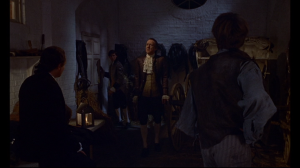February 23, 1964 – The Scarecrow of Romney Marsh, Part III Premieres on Television

“Do you trust me? All of you? Or will you stand forward now, and say that you’re afraid?”
On February 23, 1964, the Wonderful World of Color Disney anthology episode premiered with the third and final part of the three-part dramatic story of The Scarecrow of Romney Marsh. It was based on the Christopher Syn stories by Russell Thorndike and William Buchanan. Teleplay was done by Robert Westerby, and it was directed by James Neilson. It stars Patrick McGoohan as Dr. Syn/The Scarecrow, George Cole as Mr. Mipps, Michael Hordern as Thomas Banks, Geoffrey Keen as General Pugh, Eric Flynn as Lt. Philip Brackenbury, and Sean Scully as John Banks.
The episode begins with General Pugh reporting to the King, sadly informing him that the whole countryside protects the Scarecrow. The King is furious with Pugh’s incompetence, but Pugh asks for just one more month to capture the Scarecrow. The King reluctantly complies. Meanwhile, Dr. Syn is working on ideas with Mr. Mipps when a stranger appears at the door. The stranger, sent by Mother Hathaway, is American Simon Bates, branded a traitor for preaching sedition. Syn can’t hide him in his church, but sends him to the local inn for safekeeping. Later, as Syn is visiting the Banks residence, another stranger is seen fleeing from the British troops and hiding in the Bates’ yard. Pugh enters the house and informs them all of a house-to-house search for the fugitive. John walks Syn out afterwards, and the pair spy another man running into the stables. Syn alerts the deserter that he’s there to help, not to harm, and realizes that the stranger is none other than John’s brother Harry, who had been missing for years. Harry has deserted from the Navy, and cannot go inside, as he will surely be captured. Things get worse for the Banks, as Kate’s beau Lt. Brackenbury’s proposal for marriage is shot down by Kate’s father Sir Thomas Banks.

Harry is surprised to find that John brought their father to see him
In the stables, Harry is ranting about the horrible Navy conditions, when Thomas is brought in by John. Upon seeing his son, he embraces him, and is shocked to hear what had happened to him the past four years. Syn offers to take care of Harry while Thomas and John must deal with Brackenbury. Syn manages to take Harry to hide in the church’s crypt, and are soon joined by Simon Bates and Mipps. The two fugitives are sent to a barn with a hidden stable underground to hide, while Mipps and Syn work on the next plan for the Scarecrow. Unfortunately, the barn has a pair of soldiers inside, and Harry and Bates are apprehended and taken to Dover Castle. Realizing the danger that everyone is in, Syn decides to go to Dover to see what he can find out. Syn and Banks talk to Pugh, and find that the two men are to be tortured. They find an unlikely ally in Brackenbury, which Syn believes will work in his favor. Syn then heads to the prison and witnesses six men being captured for the Navy’s service. Harry and Bates are brought in, obviously tortured, and Syn asks to be alone with the prisoners to pray. As the prisoners pray, he gets an idea using the naval picket free every last man.
John is concerned about his brother, and Syn isn’t sure himself if he can get the men to escape, but comes up with a wild idea and makes a copy of the jailer’s key in the remaining wax from a nearby candle. He has Mipps arrange a meeting held by the Scarecrow for that night, as time is of the essence. The Scarecrow’s men wait in the barn, and the Scarecrow changes the recent plan to capture the ship and steal the men from Dover Castle. The men agree to help, and the plan is quickly set in motion, with Syn and John playing themselves this time. They first head to Mrs. Waggett’s Inn to capture the Navy men to steal their uniforms. The Scarecrow’s men then enter Dover Castle as a Naval Picket, with Brackenbury assisting once he recognizes John, though he makes John wait outside. Syn, leading the group, convinces Brackenbury to assist him in freeing the prisoners. Inside the cell, Syn gives the men orders, and as they prepare, they are almost caught by the jailer. The group finally manages to make it outside, but are caught by General Pugh. John manages to save them from being caught, and the men all make it out alive.

Kate and Thomas are captured by the Scarecrow’s men
At the Banks estate, Hellspite appears with a few men to gather Thomas and Kate, as the Scarecrow needs them as hostages. At the ship, John says his farewells to his brother, and the men head to the ship while John and Syn become Curlew and Scarecrow. Scarecrow has asked for Thomas and Kate to come to give Harry their goodbyes before he and the other men set sail for America. Brackenbury is later questioned by Pugh, who is furious. Brackenbury has already covered his bases by submitting reports to the Admiral and above, which will surely call for Pugh’s dismissal. In the end, Thomas and Syn drink to the Scarecrow, while Brackenbury has resigned his commission and is allowed to wed Kate.













